Aztec Architecture: Floating Gardens & Aqueducts in Tenochtitlan

A visitor looks at the remains of the Templo Mayor, which was in the center of the city of Aztec city of Tenochtitlan. From floating gardens to an advanced aqueduct system, Aztec architectural achievements allowed hundreds of thousands to flourish in the city until Spanish conquistadors stepped foot on shore. (Photo by: Jair Cabrera Torres/picture-alliance/dpa/AP Images)
Updated August 30, 2024
March 15, 2019 ~ By Shari Rose
From life-sustaining aqueducts to floating gardens and advanced irrigation systems, Aztec architecture in Tenochtitlan endowed this capital city with the largest concentration of people in Mesoamerica
Founded in 1325, the Aztec city of Tenochtitlan was a hub of architectural and agricultural innovation, allowing the Aztecs to develop technological advancements unseen in other civilizations of the time. After its fall, modern-day Mexico City was built atop the ruins of this floating city, sealing away the complex aqueduct and irrigation systems below the earth. From floating gardens atop broad lakes to aqueducts that carried plague-free freshwater to homes and buildings, Aztec architecture utilized a range of inventive technologies for new water systems that supported Tenochtitlan’s staggering population growth and separates this empire from other major civilizations in the Western Hemisphere.
- How the Floating City Was Built Atop a Lake with Aztec Architecture
- Aztec Aqueducts: Tenochtitlan’s Incredible Feat of Architecture
- Floating Gardens: Irrigation Technology Using Lakes to Their Advantage
- Spanish Conquistadors Marvel at the Chapultepec Aqueduct
- Legacy of Aztec Architecture & Aqueduct Systems
How the Floating City Was Built Atop a Lake with Aztec Architecture
The actual size of Tenochtitlan is believed to have been about five square miles, situated on the western side of Lake Texcoco. The lake itself was connected to four other smaller lakes, some with freshwater and others with saltwater. Aztec laborers faced an array of challenges when building on surrounding islands and marshland, so how exactly were the Aztecs able to construct Tenochtitlan on top of a lake? Because Lake Texcoco was fed through springs, not flowing rivers, the lake was shallow and its waters calm. This made irrigation possible.
Over time, the Aztecs discovered irrigation technologies and built water systems, such as aqueducts, to construct artificial islands on top of the lake and its surrounding bodies of water.
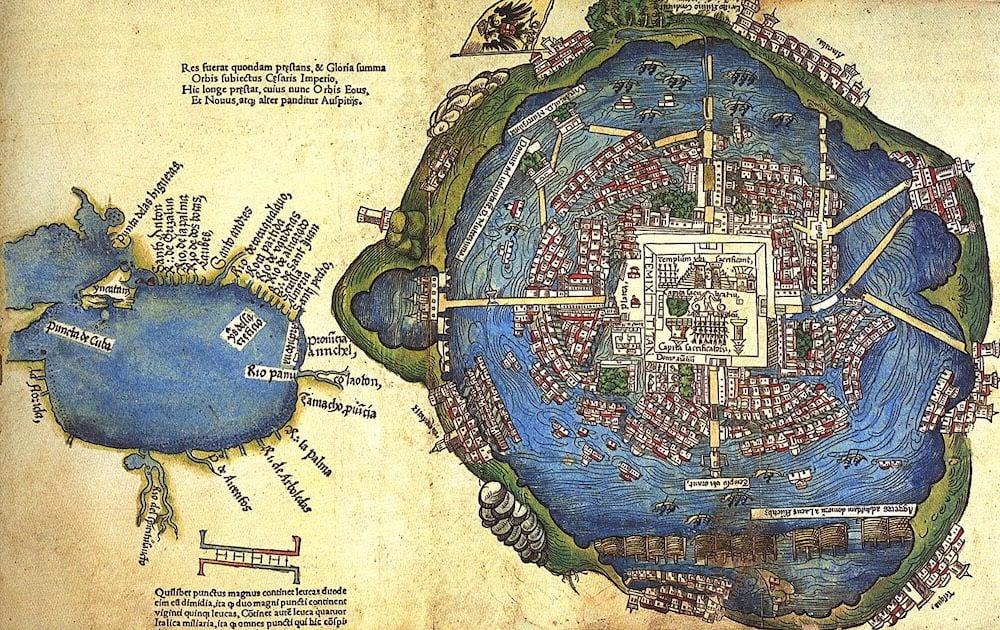
A 1524 map shows the city of Tenochtitlan with its surrounding lakes and islands. (Source)
At 2,100 square miles, Lake Texcoco was not an easy environment to make livable. But the Aztecs would take advantage of the natural resources around them to build complex aqueducts and other water systems that successfully nourished hundreds of thousands of civilians in Tenochtitlan. These architectural achievements made it possible for the largest concentration of people in Mesoamerica to flourish for generations in this floating city.
Aztec Aqueducts: Tenochtitlan’s Incredible Feat of Architecture
Carrying massive amounts of water from the Chapultepec springs, the Chapultepec aqueduct was the primary source of freshwater to Aztecs in Tenochtitlan. Resting on multiple, human-made islands for stability, this aqueduct was a colossal architectural achievement because of its twin-pipe water distribution system.
With two pipes transporting water, the Aztecs could simply divert water from one pipe to the other, should one become dirty or damaged. As a result, Aztec civilians living in Tenochtitlan always had access to fresh water, a luxury that many other civilizations of the time never experienced.
The Aztecs also built a wooden walkway along the length of the Chapultepec aqueduct so it was easily cleaned and maintained. Unlike the Roman aqueducts that often carried pollution and disease to cities, the architecture in Tenochtitlan ensured that Aztec aqueducts were not plagued with, well, the plague.
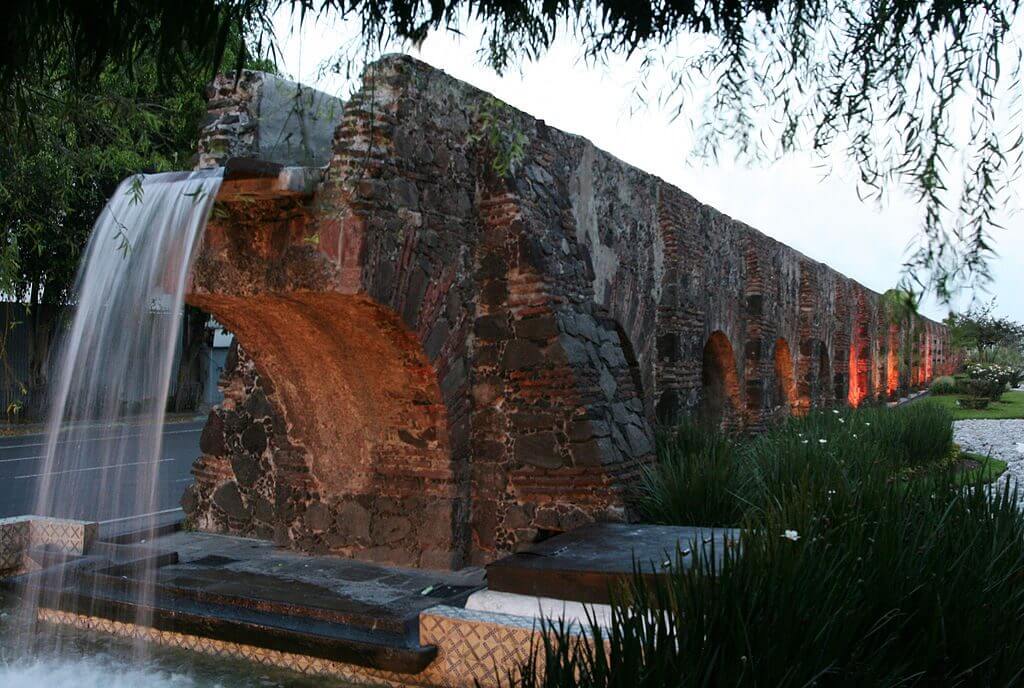
The Chapultepec Aqueduct, a work of Tenochtitlan architecture still found in Mexico City. Today, the only remaining piece of the aqueduct can be found near Metro Sevilla. (Source: Wikimedia Commons)
Along the walkway placed next to this aqueduct, laborers consistently cleaned and repaired the lifeline for the city. The water from the Chapultepec springs was occasionally used for irrigation needs, but it was utilized mainly for cleaning and bathing. The Aztecs are widely believed to have bathed twice a day, a practice that would have not been possible without this incredible innovation of Aztec architecture and irrigation.
- More stories: Jovita Idár’s Fight for Mexican-American Rights in Texas
- More stories: The Lack of U.S. Latino Representation in TV Shows & Films
This feat of Aztec architecture and agriculture ensured that Tenochtitlan’s inhabitants would be well-cared for with a seemingly endless supply of fresh water. As for the city’s crops and farming needs, Aztec laborers converted much of the remaining freshwater lakes and swampland into cultivable gardens.
Floating Gardens: Aztec Irrigation Technology Using Lakes to Their Advantage
When the Aztecs first established the capital city of Tenochtitlan, they faced many challenges with cultivating their own food in the area. There was erosion and flooding to contend with, as well as the loss of soil fertility. Plus, much of the land featured steep slopes that didn’t support crop growth. Arguably, their biggest obstacle was the sprawling swampland in the region’s lakes and rivers.
So, how did the Aztecs figure out a way to feed approximately 500 people per square mile with this kind of environment in Tenochtitlan? Through constructing chinampas, their floating gardens, the Aztecs converted thousands of acres into farmable land for their civilization.
By reworking the surrounding lakes and swamplands into structured gardens, the the city enjoyed multiple harvests per year from well-watered crops. This practical yet stunning advancement combining Aztec architecture and irrigation technologies is another example of how Tenochtitlan separates itself among other civilizations of the era by successfully growing food on a non-sedimentary lake.
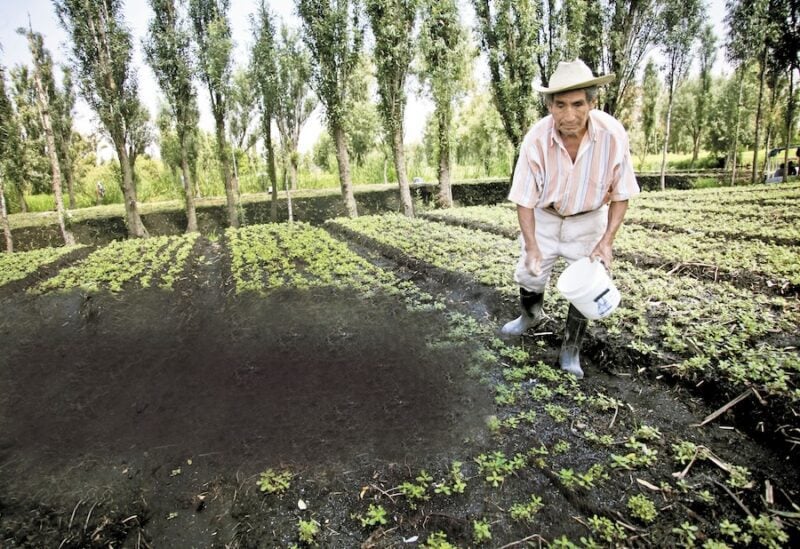
A farmer tends to floating gardens in Mexico City. (GDA via AP Images)
Constructing floating gardens was a straightforward irrigation process achieved with simple tools and ample human labor. First, using a series of wooden stakes and plant material, Aztec laborers fashioned long, rectangular plots into the lake bed. Chinampas were uniform in size, with most constructed at 98 feet long and eight feet wide. These measurements ensured that canoes could fit between each floating structure. The Aztecs then filled each chinampa with soil and vegetation until the pile reached the lake’s water level. Finally, they planted willows around the plots to keep these floating gardens in place.
- More stories: Riot Dogs: El Vaquita, Loukanikos & Others Who Joined Protesters Against Police
- More stories: Xóchitl Guadalupe Cruz López: How Child Inventor is Changing Lives
In the early days of Tenochtitlan, flooding was a significant problem for the lake-dwelling gardens. To control the flow of water to the chinampas, Aztec laborers built a complex aqueduct and irrigation system that included dams and gates to control water flow. When the dry season hit in summer, they physically carried water to the plots. In total, the Aztecs converted 30,000 acres of marshland into farmable floating gardens.
Through this agricultural feat, the Aztecs didn’t have to rely on Earth’s natural seasons. They reaped multiple harvests during the year and enjoyed a well-fed population that supplied their expanding labor force. The success of chinampas was a significant reason why Tenochtitlan had such a booming population and became the most densely populated region in Mesoamerica. But that would rapidly deteriorate with the arrival of Spanish ships along the shore.
Spanish Conquistadors Marvel at the Chapultepec Aqueduct
By the time Spanish conquistadors entered the royal palaces of Tenochtitlan, the floating city boasted between 200,000 and 300,000 residents. And unlike other civilizations at the time, most Aztecs were not farmers. Rather, they were merchants, craftsmen, warriors, clergy members, and city administrators.
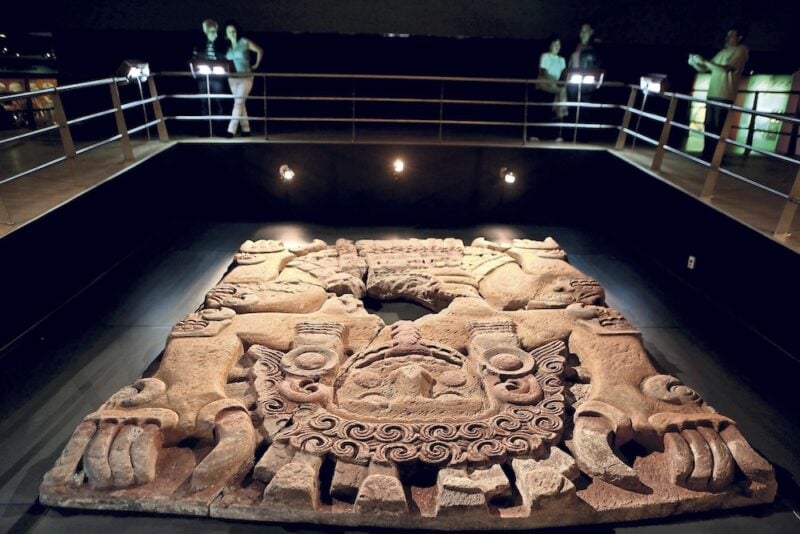
Onlookers view a well-preserved Aztec artifact unearthed from the ruins of Tenochtitlan in Mexico City. Foto: Agencia EL UNIVERSAL
After Hernán Cortés and his men met with the Aztec ruling class, they were invited to explore the city. In the most bustling part Tenochtitlan, the Spanish were astounded by the sheer volume of goods transported into the city by canoe and aqueduct. In his personal diary, Cortés noted how perfectly interwoven the aqueducts and canals were linked on the streets of Tenochtitlan.
“All the streets at intervals have openings, through which the water flows, crossing from one street to another,” he wrote. “And at these openings, some of which are very wide, there are also very wide bridges, composed of large pieces of timber, of great strength and well put together; on many of these bridges ten horses can go abreast.”
Streets were divided by goods that Aztec merchants had for sale, with whole avenues dedicated to pottery, fish and fowl, jewels, and precious stones. Innovative Tenochtitlan architecture allowed for a diversity of shops, markets, and other buildings in the heart of the city to be accessible by most Aztec inhabitants.
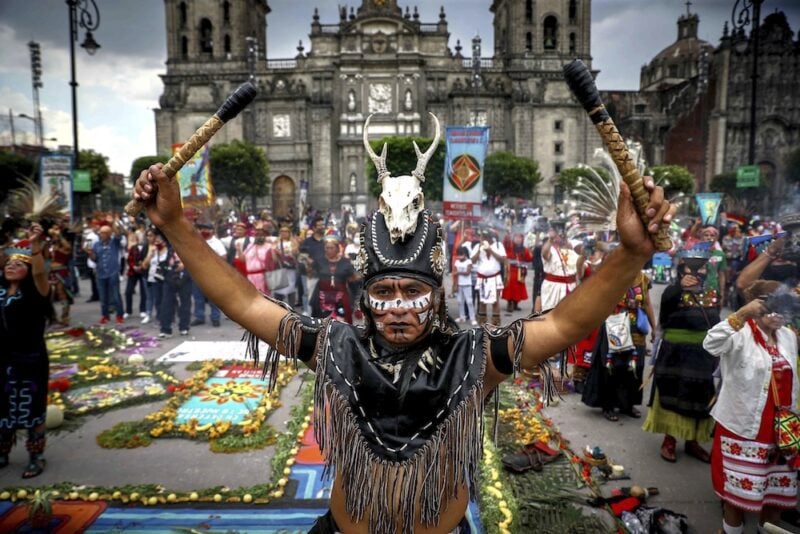
Participants from indigenous communities across Mexico gather in capital city’s Zócalo on August 12, 2021 to commemorate the 500 years since the arrival of Spanish conquistadors to Tenochtitlan. (Agencia EL UNIVERSAL/Diego Simón Sánchez/EELG)
Because it was the lifeblood that fed Tenochtitlan, the Chapultepec aqueduct proved to be the Aztec’s weakest link after the arrival of Spanish conquistadors. During the Spanish conquest, conquistadors choked off the aqueduct’s access to the city, destroying the irrigation system, and the Aztecs quickly began to starve.
- More stories: Police Shootings of Latinos in Los Angeles, 2016 – 2021
- More stories: How Ruben Salazar Gave Voice to Chicanos Until He Was Killed by Police
Fall of the Capital City of Tenochtitlan
In 1519, Moctezuma II greeted Hernan Cortes and his men in the Aztec palace that boasted unbelievable riches of gold, silver, gems and other precious resources. The Spaniards stayed in Moctezuma’s palace for some months, until the Feast of Toxcatl, where scores of Aztec nobility were killed by conquistadors.
In the aftermath, Cortes held Moctezuma captive in his palace until he was killed. Because differing first-hand accounts blame one other for his death, we may never know for sure how exactly the emperor died in his palace.
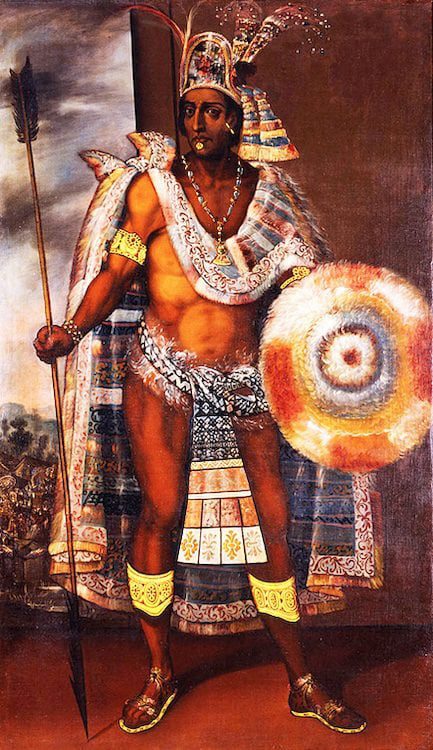
Moctezuma II featured in a 1680 painting. (Source)
However, there are two accounts concerning Moctezuma’s murder that are widely accepted by historians. The first account points the finger at rebelling Aztecs who were displeased with the leader’s rule, and killed him with a stoning. A second account contends it was the Spaniards, still holding Moctezuma hostage in the palace, who killed him in their eagerness to take control of the city.
In the bloody aftermath, Cortes barely escaped Tenochtitlan with his life. In 1521, he returned some time later with an army of some 70,000 troops, mostly Mesoamerican warriors from other societies with an interest in taking down the city.
Cortes’ forces destroyed the Chapultepec aqueduct, decimating a key part of Tenochtitlan architecture and starving the city. At the same time, the Aztecs were hit with a smallpox epidemic for which they had no immunity. Warriors were unable to walk, let alone fight in these conditions. Spain declared victory in August 1521, while the remaining armies sought to kill whomever remained alive in Tenochtitlan.
Legacy of Aztec Architecture & Aqueduct Systems
The Aztecs are probably most famous for their human sacrifice rituals, but there is just so much more to know about this incredible civilization. Their ability to not only survive, but prosper, in a strange and difficult environment surrounded by water by inventing original technologies is a marvel in its own right. Aztec innovations in architecture, irrigation, and agriculture, most of which the world had never seen before, ensured that Tenochtitlan would be remembered as a floating city unlike anywhere else in the Western Hemisphere, forever sealed away beneath modern-day Mexico City.







What are your sources?
My sources are linked throughout the post actually